We may receive a commission when you use our affiliate links. However, this does not impact our recommendations.
First a warning: Don’t read this blog entry if you already obsess too much over the details of your furniture. This entry could only make things worse.
Years ago, a high-end finish carpenter infected me with a disease for which there is no cure: clocking your screw heads. What is “clocking” – sometimes called “timing?” This is when you get the slots in all your screw heads to line up, either horizontally or vertically.
This carpenter pointed it out to me on a job he was working on. When he installed switchplates or hardware on cabinets, he always clocked the slots and said it was a mark of good workmanship. Since that day I have always looked out for clocked screws on furniture and cabinetry and have clocked my own screw slots when they are visible.
It’s a fairly uncommon feature on furniture, though it is common in other trades. I’ve met gunsmiths who clock all the screws on high-end firearms. I’ve also seen it on nice astronomy equipment.
So how do you do it?
Well there are lots of methods – enough to write a 10-page article on. When you are driving machinist’s screws into metal you might even use special screws designed for this. The head of the screw comes too tall for the hole. So you drive it in and mark where you want the slot to go. Then you remove the screw, file the head flush and cut a new slot with a hacksaw.
There are also ways to clock screws by machining the underside of the screw head.
In woodworking, you don’t need to go to those extremes to clock your screws. The way I do it is fast. It adds only a few minutes to installing a piece of hardware. But before I show you how, let me stress that this is not something I recommend you necessarily do in your furniture. I get obsessed about hardware and I might have mild OCD. That said, here goes.
1. Do all this before you color your hardware (if you are going to color it). This process can remove some of the color from your screw countersinks.
2. One method that some people recommend is to drive the screw, then remove it and just drive it again. This method doesn’t work well for me. I don’t want to cross-thread the wood and potentially weaken the screw’s grip.
3. So what I do is to drive in the screw and note how far off the slot is from vertical. Then I remove the screw.
4. Sometimes I will take a countersink and twist it by hand to remove a little bit of metal in the screw’s recess. This is fast and it works well – it usually takes four or five twists to adjust a screw by a quarter-turn. I actually don’t prefer this method, however, even though it is fast. I’d rather adjust the screw (which is disposable), than the hinge (which is expensive).
5. So what I do is wrap the threads of the screw in some masking tape and chuck the tape into my drill press or a cordless drill clamped to my benchtop. I set the drill on fast speed and spin it. Then I take a triangular saw file and touch it to the underside of the screw head. This turns the underbelly of the screw head down a bit. It takes only about 5 seconds of filing to make a difference. Then I unwrap the screw and drive it in.
By the way, I’m not alone in my obsession. Toolmaker Colen Clenton clocks the heads in his beautiful squares. He uses square-drive screws and clocks them to look like diamonds. Nice. There probably should be an encounter group for people like us. I’ll bring the doughnuts.
— Christopher Schwarz
P.S. I know there are still other methods for clocking screws that use epoxy. But I’ve done enough damage today already to your supply of valuable shop time. And if you think I am compulsive, then you should read James Krenov’s masterpiece “A Cabinetmaker’s Notebook.” Krenov was the king of details and opened my eyes to many things important to the craft.
Here are some supplies and tools we find essential in our everyday work around the shop. We may receive a commission from sales referred by our links; however, we have carefully selected these products for their usefulness and quality.




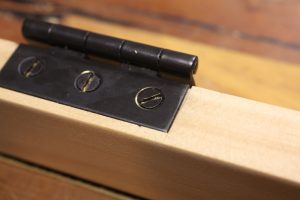
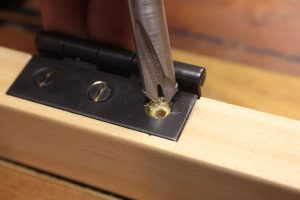
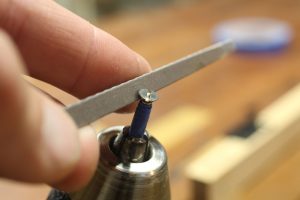
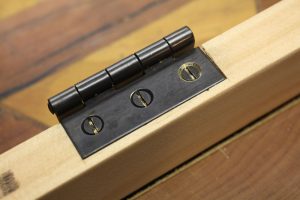
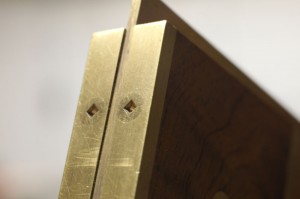





Realise this is an old thread now, (no pun intended,) but you have all made me realise my screw head ocd is ok! I started lining up at college thinking it looked better, and then my tutor told me how a cabinet maker had showed him the same when he was young, “it sets aside the quality of the joiner” , I thought it was me just over fiddling as usual! I’m lucky enough to have a good stock of my dad’s slot heads, so constantly going between metric and imperial gauge, still keeps it all in the brain. So off to get my t-shirt printed!
A season craftman and woodworking tutor explained that as a apprentence, he was taught to alighn the slots with the grain direction as a normal practice. Peter (Australia)
One time I asked Krenov about “clocking” screws. ( I was a student when he was teaching in 1992) His response was that he does not clock the screws as perhaps they are not as tight, or my interpretation was that the function of the screw was more important than the way they looked. His response says alot about the way he looks at estetics. And to some perhaps the screws are more beautiful in a random unselfcontious pattern.
I didn’t write this to be catty or to say “It is wrong to clock screws” (I say do whatever apeals to you.) I just thought it funny that I had to put a little story that was so aplicable to your blog.
This sounds like something my dad would do. Pretty cool to the me the observer, once i figured out what he was doing, I looked for it everything he did. I think of it more as a fingerprint. Something that reflects the builder… I think it meant he spent a lot of time doing what he did and took some satisfaction.
I recently viewed a sewing box made by my Great, Great, Great Grandfather in is on display in one of Australia’s premier art galleries. The thing that struck me was the screws and hinges, the hinges were brass and the screws were steel and not clocked. After having discussions with the curator and also a 17th century furniture restorer friend I have been told that this was common practice (steel screws and not clocked that is) for fine furniture of the period, so is clocking the screws a modern thing? I agree it looks better but in the past it was not done a sign of good workmanship they left that for the jointing and finish.
If I could post pictures I would post some to show the quality of his work.
Although I have actually done it on occasion, I usually try to resist the urge to align screw slots. However, this reminds me of an incident along the lines of OCD.
A few years ago I asked a very meticulous machinist to make some u-shaped brackets for mounting a large leaded-glass shield on a piece of scientific equipment. I gave him a rough sketch with a lot of latitude, and soon received four beautifully machined aluminum brackets that looked like large extra-wide tuning forks.
Taking the hint, I tapped on them, and they all rang out. Pretty soon I was glued to my watch counting very infrequent beats – they were all well within 1 Hz of each other in frequency. He had machined them so precisely, they all rang at exactly the same pitch. Knowing this machinist, I wasn’t too surprised.
However, he had his laugh the next day, and I was blown away, when I brought in a real tuning fork and found that all my brackets rang at precisely the same note as the tuning fork – the standard A above middle-C, 440 Hz.
I’d like to think that whoever installed these brackets on the instrument also thought to clock the screws. I have to confess, though, I never thought to check.
BoltDepot.com has a very large selection of fasteners including slotted wood screws with several head forms in brass, ss steel, zinc plated steel and silicon bronze. I placed orders with them many times for steel and brass screws and bolts in numerous sizes. Great company.
Call me an AR or OCD 69 year old, but I have done clocking all my life (yes, even with switch plates). Why? Because my perfectionist, machinist and beloved and departed Dad taught me this way. Given the superb quality of everything he built including my childhood home, a handmade 48 inch machinist/wood lathe that I still have and use, and a portrait camera ( just to name a few items) I figured that was the best way to install screws. Until now, I never knew the technique’s name, but now thanks to Chris I do. I have learned the filing technique from this blog to make it easier, but with careful recollection, I remember seeing my Dad do that filing on screws as Chris has shown, but until now I did not why he did it.
Thanks, Chris.
Clocking out now, I have to go dot a few “i’s” , wash my shoelaces and clean the inside of my car’s exhaust pipe.
Mike O’Brien
Guess I have a name for my OCD too! Fact is when I built houses the electrician would clock his screws on the switch and outlet cover plates. Straight up and down. It’s the little things people don’t notice that make a difference in the look of a project.
This reminds me of an OCD problem I have. All throughout my house the screws on all the electrical outlet and switch plates are aligned straight up and down. This did not happen all at once, but over time – whenever I approach an outlet, if the screw(s) are misaligned, I stick my thumbnail into the screw head and tweak it.
I’ve been known to do this at work, at other people’s houses. where ever I go.
It takes no time at all, and I feel better about it. Harmless “problem”? I hope so!
Another source; boltdepot.com
I’m obviously undereducated and sloppy. Though I’ve been “clocking” my phillips and square drive screws for some time I’ve never heard of a term for it; just thought it looked nice. I’ve never used a “technique” for it either; just drive the screw a little further (quarter turn max for phillips and square drives) to line it up with its neighbor. Is there really a need for all the time consuming techniques of clocking a screw?
Geoff
Hi, Chris,
I “clock” screw heads as you describe, although we usually call it “align” here in Australia and I always do it with the slot in line with the stile, rather than perpendicular to it as you have done.
Cheers,
Ian.
Why does Chris insist on doing things the hard way? The easy answer to clocking the screws is to try a different screw, the slots are not lined up with the wood threads at the factory, so a different screw may just line up better than the one giving you brain fits.
My OCD is actually a little bothered by the clocking – I like the more usual stochastic pattern. It’s like tuning a drumkit to a certain key – you’re not supposed to do it, you leave it random. It can interrupt the harmony of the other instruments. Likewise, lining up the screws looks too much like a design feature – an unwanted one. When it’s random, it disappears into the background (to me).
Thanks man, I thought it was just my OCD rearing it’s ugly head at screw time….whew
Most places, you can’t get slot headed steel wood screws. The only places I’ve found have been a few hardware stores that have been closing due to retirement of the owner (often in a pine box). I hear that they are available in Brazil, where just to be contary, you can’t find anything else.
The majority of online stores only carry brass slotted screws, and some of them now only offer Philips head screws (in brass??)
So – anyone prepared to list some on-line suppliers?
At least now I know my illness has a name – and potentially a support group – how about a t-shirt?
This may be more widespread than first thought. I once owned an old Mercedes 300D that needed some work. The mechanic where I took it told me he installed a battery and his boss jumped all over him because the cables weren’t perpendicular to the battery housing. Yes, the boss was German.
Perhaps Screw-Clockers Anonymous isn’t enough.
Richard
I have been clocking screw slots for some time. Never thought too much about it. I have never figured out for myself whether the slot looks better in the vertical or horizontal. So I alternate from project to project or sometimes it just looks better one way or the other. I feel so weird exposing myself. I may need help.
I started my own woodworking sojourn via Mr. Krenov’s treatise on the mindset of “working” wood.
How about Screw-Clockers Anonymous? I’d go.
I read about (but have not tried) an alternate method of doing this that basically involves tapping the screw down to a constant depth before starting to turn it. Done properly this should result with the head at the same position for each screw. Varying the thickness of the spacer used to set the depth will allow control over the rotational alignment.
My screw alignment habit [obsession?] first started with aligning slotted screws vertically on all the electrical switch and outlet cover plates. I noticed that I was not alone in this while visiting at a friend’s home. But he had all his slots horizontal.
I smugly pointed out the fallacy of horizontality: slots are more aesthetically aligned vertically with the electrical plate or hinge vertical components. And vertical slots do not capture dust!
Consequently horizontal slot fans have the choice of spending some hours today realigning every slot in their house to vertical, or using a feather duster at least once daily for the rest of their lives 😉
I have the same mild O.C.D. as you Chris,
plus i also “clock” my screws so the groove’s
line up with the grain of the wood.
Chris or Megan,
Will you please explain the process of coloring that Chris mentioned “1. Do all this before you color your hardware (if you are going to color it)”? Megan I added you to this request because of your comment “I can report what really makes a girl cry is to buy expensive oil-rubbed bronze hardware, then fuss about “timing,” only to have perfectly aligned heads…off which the finish has been scratched”.
Thanks for the great work. Todd
This isn’t just OCD though – if it’s a screw that takes any forces, timing all the screws in the project lets you know quickly if a screw is working it’s way loose. (At least, that’s what I’ve been told by the one who infected me, and that’s been my excuse.)
21 posts within hours of publication. Wow! The world is falling to the OCDs, screws in-hand.
Does it not bother you that the screws are not all inset to the same depth?
I just find it hard to believe that this is the only article on Chris’s blog that shows up under the tag “Anal-Retentive Woodworking”. 😎
Just kidding, tips on these little touches are great for bringing our projects up a notch.
Some gunsmiths building longrifles in the Golden Age, 1770-1820, aligned screw heads, generally in line with the bore, when installing furniture such as brass butt plates and side plates, iron trigger plates, and particularly brass patchboxes, supposedly as a sign of workmanship and attention to detail. They often made the iron screws as well as the brass patchbox finials and sideplates, and would deepen the screw slots with saw and needle file before installing. They’d countersink the brass parts for the screws, install the screws, and then file the screws and patchbox down together for a flush fit. The deepening allowed the screw to be removed after it was filed down. Some used rounded or oval head screws which were not finished flush with the box, although the slots were commonly aligned parallel with each other or aimed at a common point such as the end of the patchbox finial.
When I first became an electrician I was taught to always “soldier” the screws on wall plates, panels, and fixtures where applicable. If you didn’t solidier your screws you basically got yelled at. It’s good practice and looks much more professional. I guess that applies to woodworking as well.
I have been doing this for years, ever since I had seen an electrician do it with switch and outlet covers. I am also severly OCD so don’t mind me!!
Nate
Wow, you folks are all nuts. I will never even think about having the slots on my switch plates lined up. Having said that, the next time I use screws that show on a piece of furniture, I probably will line them up. Like tiny dovetails, it’s one more sign of attention to detail. After putting in many hours of work on a project, a few more minutes won’t hurt.
I own a 130 year old house and use a dremel tool frequently. It has an abrasive cutoff wheel that I use to recut grooves in ancient slot-head screws that someone long ago stripped. Ord to clean out a dozen layers of paint.
But now the screw head isn’t flush with the hinge plate, that would drive me almost as crazy as not having the slots line up (especially in this case where the brass is showing instead of ORB). I usually use gimlets to start the threads, makes it easier to align the heads by starting with the gimlet the same way on each hole.
I can’t find a good pic to link to, but the famous H.O. Studley Tool Cabinet has all the screws around the frame clocked vertically. Pretty impressive.
I didn’t notice the warning.
I DID notice the screws and said to myself “Oh, look, someone else lines up their screws. But why are they horizontal and not vertical?”. So I clicked.
THEN I read article.
But I don’t understand why this is a problem . . .
This is just good sense. I started doing it after painting too many rooms. Didn’t know it had a name. Won’t my wife be surprised. I emailing her the link.
“…and I might have mild OCD.”
lol
(And your disclaimer wasn’t strong enough, Chris… I still read the article. But teasing someone who is OCD with yet another way they can BE OCD really isn’t much of a disclaimer to not read the article, then, is it?)
Oh, and…
“…off which the finish has been scratched”
Wonderfully written, Megan. 🙂
Arrrrgggghhhh!
My wife thinks it hilarious to turn a screw on a random switch plate and see how long it takes me to notice and fix. The longest a screw has so far stayed misaligned is less than 12 hours.
Don’t judge me.
After all these years I’m glad to see I’m not alone in my madness.
On a very related note I guess you guys too will relate to this:
http://tinyurl.com/32ruzko
Keep up the amazing work you do and know you have (at least) one loyal follower in Japan.
Having been infected with this dread disease (I won’t say by whom), I can report what really makes a girl cry is to buy expensive oil-rubbed bronze hardware, then fuss about “timing,” only to have perfectly aligned heads…off which the finish has been scratched. 🙁